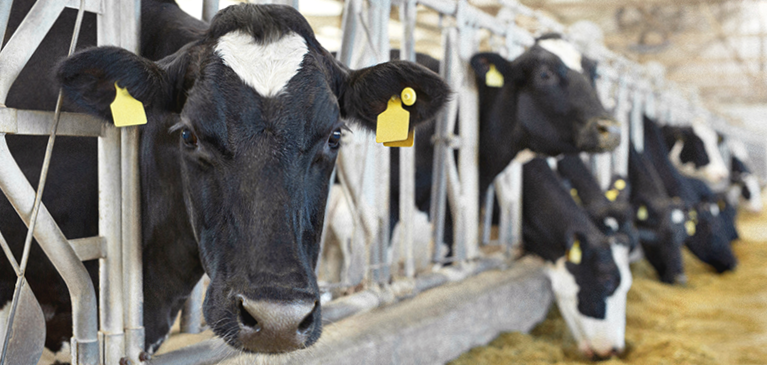
The United States dairy industry is both bullish and bearish for producers, with many factors potentially influencing the future.
While export demand and record-high processing investment offers momentum, policy uncertainty – spanning labor, trade and nutrition assistance – combined with soft domestic demand has created downward pressure.
Milk prices are seemingly carrying over from last year with strong milk prices in the first quarter. Growers are also experiencing lower feed costs. However, tariff discussions recently caused some volatility in the futures markets, especially for Class III (cheese) prices.
“There’s always volatility in our industry, but cheese prices have rebounded and are currently profitable, with futures indicating sustained profitability for the next 6-12 months,” says Mitchell Schafer, vice president of agribusiness lending at GreenStone Farm Credit Services. “It’s no longer just, ‘what’s my local milk price?’” he says. “Some of the rebound in milk prices came from the export market, where the U.S. has competitive prices in the global cheese market. Retaliatory tariffs remain a concern.”
The U.S. dairy market is heavily influenced by international competitiveness, with approximately 16% of milk solids currently being exported, according to Leonard Polzin, Dairy Markets and Policy Outreach Specialist at the University of Wisconsin-Madison Extension.
High dairy market prices have been historically influenced by either reduced production or increased exports. As the industry looks towards the future, maintaining competitive pricing on the world stage will be crucial for sustaining strong margins, Polzin says. The U.S. exports nearly one-fifth of dairy components, primarily nonfat solids, with Mexico, Canada and China collectively accounting for about 40% of the total value of U.S. dairy exports in 2024, according to Polzin.
Investment in Processing Infrastructure
Capital costs and interest rates are higher than they were four years ago, posing challenges for growth, according to Schafer. However, there is expansion, as the U.S. dairy industry is experiencing substantial investment in processing infrastructure, exceeding $8 billion nationwide, with some estimates approaching $9 billion. Notable projects include:
• Walmart’s $350 million facility in Robinson, Texas, expected to be operational by 2026
• Fairlife’s $650 million fluid milk plant in New York
• Chobani LLC’s recently announced $1.2 billion dairy processing facility, which broke ground on April 22 in Rome, New York
This surge in milk processing is expected to create a higher demand for milk and could lead to a more stable and profitable market for dairy farmers. The price bump may stretch out depending on how long it takes for farmers to align production.
Much of the new processing investments are concentrated in cheese production. U.S. cheese exports have outperformed expectations due to lower prices relative to the European Union, where tight milk supplies have driven prices higher. This price gap has made U.S. products more competitive, but the advantage is fragile, according to Polzin.
Milk Solids Production Continues to Increase
Despite a 0.35% year-to-date decline in total milk production in 2025, calculated milk solids production increased by 1.65% as of March 2025. This increase in production efficiency coupled with an increase in the national herd of 15,000 head from January to March of 2025 and an increase of 57,000 head year-on-year, means the industry can meet new demand for milk solids more quickly than in the past, according to Polzin.
High oleic soybeans are gaining traction for increasing butterfat and protein content in milk. “It depends on production levels as to the response growers might see,” Schafer says. “There are herds that are running trials, and some are making that switch, but it’s not cheap to put in a roaster, grinder and storage to handle it. Sourcing or growing the beans yourself can also pose challenges. Producers in the 80-pound to 90-pound range may see bumps in the components (butterfat and protein) and production, as well.”
Dairy Replacement Values Remain High
“It can be expensive to buy cows. That goes for calves, heifers and springers,” Schafer notes. “But at the same time, producers are getting pretty good money if they’re selling cull cows, or day-old black calves – at least they’ve gone up together,” he says.
Dairy replacement values are high. In April, USDA reported the average price for a dairy herd replacement ready to enter the milk barn reached $2,870. That’s up from $2,120 the same time last year.
In the final 18 weeks of 2023, dairy farmers sent 140,500 fewer dairy cows to slaughter when compared to the previous year. The big pullback continued throughout 2024, as 367,400 fewer head of dairy cows went to slaughter as dairy farmers looked to shore up herd numbers when faced with fewer heifers, according to Corey Geiger, lead dairy economist at CoBank.
That trend seems to finally be reversing. Through March, the U.S. dairy cow herd was up 80,000 head when compared to the start of 2024. However, that gain, which reached a total of 9.4 million head, has less to do with replacement inventories and more to do with a historic pullback in culling, which started in the fall of 2023.
“Some producers are getting another lactation or two lactations out of their herds,” Schafer says. “Instead of culling they are getting more milk out of them because the price is favorable right now, and because there aren’t as many replacements out there.”
Butterfat Exports Rising in 2025
Butterfat exports were 203% higher than a year ago in March at 17.9 million pounds, according to the U.S. Dairy Export Council. Canada was a major buyer as sales volume grew 172% compared to the same time last year.
“Overall, U.S. butter prices continue to be discounted compared to the two largest global dairy exporters — the E.U. and New Zealand,” Geiger explains.
While March 2024 still holds the record of 110 million pounds of cheese exported in one month, March 2025 secured the number 2 spot at 109 million pounds. Mexico remains the top U.S. dairy customer and purchased 95.5 million pounds of cheese in the first quarter of 2025.


